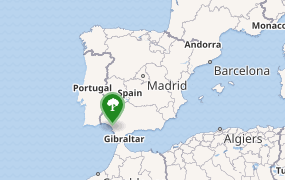Doñana National Park"

Doñana National Park is a renowned protected area located in the Andalusia region of southwestern Spain. It is considered one of the most important and ecologically diverse wetland areas in Europe. The park's unique combination of ecosystems, including marshes, lagoons, dunes, and forests, makes it a critical habitat for a wide variety of plant and animal species. Doñana National Park has been recognized for its ecological significance and is designated as a UNESCO World Heritage Site and a Biosphere Reserve.
Here are some key features and aspects of Doñana National Park:
-
Geographical Location: The park is situated in the provinces of Huelva and Seville, along the Atlantic coast of Spain. It covers an area of approximately 543 square kilometers (210 square miles) and extends from the Guadalquivir River delta to the sandy shores of the Gulf of Cádiz.
-
Biodiversity: Doñana National Park is celebrated for its rich biodiversity. It serves as a critical stopover point for migratory birds traveling between Africa and Europe. The park provides essential breeding and wintering grounds for numerous bird species. It is estimated that over 300 bird species have been recorded in the park, including the greater flamingo, purple heron, and Spanish imperial eagle.
-
Mammals and Other Wildlife: The park is also home to a variety of mammal species, including the elusive Iberian lynx, one of the world's most endangered wild cat species. Other mammals found in the park include wild boars, red deer, rabbits, and various rodents.
-
Plant Life: Doñana's diverse habitats support a range of plant species, adapted to the varying conditions of marshes, dunes, and forests. Salt-tolerant vegetation, such as saltworts and glassworts, thrive in the park's brackish and saline environments.
-
Habitats: The park's landscapes include marshes and shallow lagoons, extensive sand dunes, Mediterranean scrubland, and pine forests. These habitats cater to different species, and the park's mosaic of environments contributes to its remarkable biodiversity.
-
Conservation Challenges: Doñana National Park faces various conservation challenges, including threats from human activities such as agriculture, urban development, and tourism. Water management is also a significant concern, as the park's delicate balance relies on the availability of freshwater from the Guadalquivir River.
-
Visitor Centers and Tourism: The park offers visitor centers and guided tours that provide insights into its natural history, biodiversity, and conservation efforts. These tours aim to educate visitors about the park's importance while minimizing disturbances to the fragile ecosystems.
-
Research and Conservation Efforts: The park serves as a valuable site for scientific research and conservation initiatives. Studies conducted in Doñana contribute to our understanding of wetland ecosystems, migratory bird patterns, and the challenges faced by endangered species.
Visiting Doñana National Park requires adhering to specific regulations to protect the environment and wildlife. Guided tours and responsible ecotourism practices are encouraged to minimize human impact on the fragile ecosystems and to support the park's conservation efforts.

